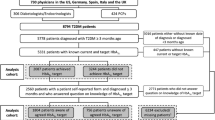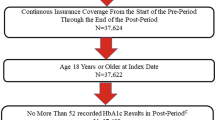Abstract
Objectives
Cost-effectiveness models for diabetes link glycated hemoglobin (HbA1c) to diabetes-related complications. Independent of diabetes-related complications, there is little known on the association between HbA1c and health utility scores. This link can alter the cost effectiveness of interventions designed to improve HbA1c. The cross-sectional relationship between HbA1c and health utility scores in adult type 1 diabetes patients was estimated after adjusting for diabetes-related complications.
Methods
The EuroQoL-5 dimension (EQ-5D) questionnaire and an ad hoc survey requesting demographic information and adherence to glucose monitoring therapies was administered to adult type 1 diabetes patients during a clinic visit and combined with clinical medical record data. Health utility scores were derived using the US time-tradeoff valuation of the EQ-5D. Linear regression was used to estimate the relationship between HbA1c and utility, adjusting for treatments, demographics, and diabetes-related complications.
Results
Among 176 patients, mean (standard deviation [SD]) age was 38 (12.2) years, duration of disease was 22 (12.1) years, and number of chronic conditions other than type 1 diabetes was 2.7 (2.0). Unadjusted mean (SD) utility was 0.94 (0.09) for those with HbA1c levels <7 % (n = 54), 0.89 (0.15) for those with HbA1c ≥ 7 % (n = 122), and 0.91 (0.14) for all patients. After adjustment, a 1 % absolute increase in HbA1c was associated with a disutility of −0.03 (95 % confidence interval [CI] −0.049, −0.006).
Conclusions
Findings suggest that, after adjusting for diabetes-related complications, higher HbA1c levels are associated with a significant health disutility. Pending additional data from longitudinal studies, these findings could be used in cost-effectiveness evaluations of type 1 diabetes interventions that impact HbA1c.

Similar content being viewed by others
References
Yaturu S. Insulin therapies: current and future trends at dawn. World J Diabetes. 2013;4(1):1–7. doi:10.4239/wjd.v4.i1.1.
Joubert M, Reznik Y. Personal continuous glucose monitoring (CGM) in diabetes management: review of the literature and implementation for practical use. Diabetes Res Clin Pract. 2012;96(3):294-305.
Kumareswaran K, Evans ML, Hovorka R. Closed-loop insulin delivery: towards improved diabetes care. Discov Med. 2012;13(69):159–70.
Hex N, Bartlett C, Wright D, Taylor M, Varley D. Estimating the current and future costs of Type 1 and Type 2 diabetes in the UK, including direct health costs and indirect societal and productivity costs. Diabetic Med. 2012;29(7):855–62. doi:10.1111/j.1464-5491.2012.03698.x.
Dall TM, Mann SE, Zhang Y, Quick WW, Seifert RF, Martin J, et al. Distinguishing the economic costs associated with type 1 and type 2 diabetes. Popul Health Manag. 2009;12(2):103–10.
Tunceli O, Wade R, Gu T, Bouchard JR, Aagren M, Luo W. Cost of diabetes: comparison of disease-attributable and matched cohort cost estimation methods. Curr Med Res Opin. 2010;26(8):1827–34. doi:10.1185/03007995.2010.488544.
Fleming TR, DeMets DL. Surrogate end points in clinical trials: are we being misled? Ann Intern Med. 1996;125(7):605–13.
Kozma CM, Reeder CE, Schulz RM. Economic, clinical, and humanistic outcomes: a planning model for pharmacoeconomic research. Clin Ther. 1993;15(6):1221–32.
Gold M, Siegel JE, Russell LB, Weinstein MC. Cost-effectiveness in health and medicine. New York: Oxford University Press; 1996.
Sullivan PW, Ghushchyan V. Preference-based EQ-5D index scores for chronic conditions in the United States. Med Decis Mak. 2006;26(4):410–20.
Rubin RR, Peyrot M. Quality of life and diabetes. Diabetes Metab Res Rev. 1999;15(3):205–18. doi:10.1002/(sici)1520-7560(199905/06)15:3<205:aid-dmrr29>3.0.co;2-o.
American Diabetes Association. Standards of medical care in diabetes—2011. Diabetes Care. 2011;34 Suppl 1:S11-61.
Anonymous. Effect of intensive therapy on the development and progression of diabetic nephropathy in the Diabetes Control and Complications Trial. The Diabetes Control and Complications (DCCT) Research Group. Kidney Int. 1995;47(6):1703–20.
The Diabetes Control and Complications Trial Research Group. The effect of intensive treatment of diabetes on the development and progression of long-term complications in insulin-dependent diabetes mellitus. The Diabetes Control and Complications Trial Research Group. N Engl J Med. 1993;329(14):977–86.
C. D. C. Diabetes Cost-effectiveness Group. Cost-effectiveness of intensive glycemic control, intensified hypertension control, and serum cholesterol level reduction for type 2 diabetes. JAMA. 2002;287(19):2542–51.
Hoerger TJ, Harris R, Hicks KA, Donahue K, Sorensen S, Engelgau M. Screening for type 2 diabetes mellitus: a cost-effectiveness analysis. Ann Intern Med. 2004;140(9):689–99.
Huang ES, O’Grady M, Basu A, Winn A, John P, Lee J, et al. The cost-effectiveness of continuous glucose monitoring in type 1 diabetes. Diabetes Care. 2010;33(6):1269–74 [Erratum appears in Diabetes Care. 2010 Sep; 33(9):2129].
Wu SY, Sainfort F, Tomar RH, Tollios JL, Fryback DG, Klein R, et al. Development and application of a model to estimate the impact of type 1 diabetes on health-related quality of life. Diabetes Care. 1998;21(5):725–31.
Coffey JT, Brandle M, Zhou H, Marriott D, Burke R, Tabaei BP, et al. Valuing health-related quality of life in diabetes. Diabetes Care. 2002;25(12):2238–43.
Currie CJ, Poole CD, Woehl A, Morgan CL, Cawley S, Rousculp MD, et al. The health-related utility and health-related quality of life of hospital-treated subjects with type 1 or type 2 diabetes with particular reference to differing severity of peripheral neuropathy. Diabetologia. 2006;49(10):2272–80. doi:10.1007/s00125-006-0380-7.
Lee AJ, Morgan CL, Morrissey M, Wittrup-Jensen KU, Kennedy-Martin T, Currie CJ. Evaluation of the association between the EQ-5D (health-related utility) and body mass index (obesity) in hospital-treated people with Type 1 diabetes, Type 2 diabetes and with no diagnosed diabetes. Diabetic Med. 2005;22(11):1482–6. doi:10.1111/j.1464-5491.2005.01657.x.
Lee JM, Rhee K, O’Grady MJ, Basu A, Winn A, John P, et al. Health utilities for children and adults with type 1 diabetes. Med Care. 2011;49(10):924–31. doi:10.1097/MLR.0b013e318216592c.
Tabaei BP, Shill-Novak J, Brandle M, Burke R, Kaplan RM, Herman WH. Glycemia and the quality of well-being in patients with diabetes. Qual Life Res. 2004;13(6):1153–61.
Koopmanschap M. Coping with Type II diabetes: the patient’s perspective. Diabetologia. 2002;45(7):S18–22. doi:10.1007/s00125-002-0861-2.
Peyrot M, Rubin RR, Chen X, Frias JP. Associations between improved glucose control and patient-reported outcomes after initiation of insulin pump therapy in patients with type 2 diabetes mellitus. Diabetes Technol Ther. 2011;13(4):471–6. doi:10.1089/dia.2010.0167.
McQueen RB. Comparative- and cost-effectiveness of continuous glucose monitoring for type 1 diabetes. ProQuest, UMI Dissertations Publishing; 2013.
Dolan P, Gudex C, Kind P, Williams A. A social tariff for EuroQoL: results from a UK general population survey, Discussion Paper No. 138. Centre for Health Economics, University of York; 1995.
Shaw JW, Johnson JA, Coons SJ. US valuation of the EQ-5D health states: development and testing of the D1 valuation model. Med Care. 2005;43(3):203–20.
Basu A, Manca A. Regression estimators for generic health-related quality of life and quality-adjusted life years. Med Decis Mak. 2012;32(1):56–69. doi:10.1177/0272989x11416988.
Pullenayegum EM, Tarride J-E, Xie F, Goeree R, Gerstein HC, O’Reilly D. Analysis of health utility data when some subjects attain the upper bound of 1: are Tobit and CLAD models appropriate? Value Health. 2010;13(4):487–94. doi:10.1111/j.1524-4733.2010.00695.x.
Zhang P, Brown MB, Bilik D, Ackermann RT, Li R, Herman WH. Health utility scores for people with type 2 diabetes in U.S. managed care health plans: results from translating research into action for diabetes (TRIAD). Diabetes Care. 2012;35(11):2250–6. doi:10.2337/dc11-2478.
Bergenstal RM, Ahmann AJ, Bailey T, Beck RW, Bissen J, Buckingham B, et al. Recommendations for standardizing glucose reporting and analysis to optimize clinical decision making in diabetes: the ambulatory glucose profile (AGP). Diabetes Technol Ther. 2013;15(3):198–211. doi:10.1089/dia2013.0051.
Glasgow RE, Ruggiero L, Eakin EG, Dryfoos J, Chobanian L. Quality of life and associated characteristics in a large sample of adults with diabetes. Diabetes Care. 1997;20(4):562–7.
Acknowledgments
The authors would like to thank Dr. Satish K. Garg, the Barbara Davis Center staff, and the study subjects for their participation. This research was funded in part by the PhRMA Foundation as part of a post-doctoral fellowship grant for RBM. RBM, SLE, DMM, HDA, KVN, AML, and JDC have declared no financial conflicts of interest directly related to this research.
Author contributions
This study was a part of RBM’s dissertation and he is the overall guarantor of the work. RBM designed the study, managed survey administration and data collection, conducted the statistical analysis, and wrote/revised the manuscript; SLE was a member of RBM’s dissertation committee and contributed to the design of the study, assisted in survey administration and data collection, and edited/revised all sections of the manuscript; DMM, HDA, and AML were members of RBM’s dissertation committee and contributed to the design of the study and edited/revised all sections of the manuscript; KVN was the process chair of RBM’s dissertation committee and contributed to the design of the study, and edited/revised all sections of the manuscript; JDC was RBM’s thesis advisor and contributed to the design of the study, participated in data management and statistical analysis, and edited/revised all sections of the manuscript.
Author information
Authors and Affiliations
Corresponding author
Appendix
Appendix
See Table 5
Rights and permissions
About this article
Cite this article
McQueen, R.B., Ellis, S.L., Maahs, D.M. et al. Association Between Glycated Hemoglobin and Health Utility for Type 1 Diabetes. Patient 7, 197–205 (2014). https://doi.org/10.1007/s40271-014-0045-4
Published:
Issue Date:
DOI: https://doi.org/10.1007/s40271-014-0045-4




